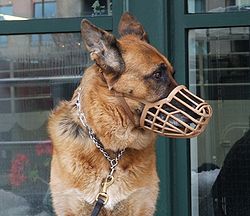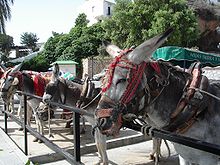- Muzzle (device)
-
A muzzle is a device that is placed over the snout of an animal to keep it from biting or otherwise opening its mouth.
An Elizabethan collar is a cone-shaped device placed around an animal's neck to prevent biting and sometimes referred to as a muzzle, though its function is more usually to prevent the animal interfering with dressings or medication applied on its body.
Muzzles can be primarily solid, with air holes to allow the animal to breathe, or formed from a set of straps that provides better air circulation and allow the animal to drink. Leather, wire, plastic, and nylon are common materials for muzzles. The shape and construction of the muzzle might differ depending on whether the intent is to prevent an animal from biting or from eating, for example.
Contents
Dog muzzles
Muzzles are sometimes used on untrained dogs, large or small, to prevent either unwanted biting or unwanted barking. They can also be used on aggressive dogs or other animals. They are usually made with a strong buckle or other fastening device to ensure that they do not come off accidentally. Muzzles are also used on dogs when there is a risk of them taking baits that have been laid for vermin.
Dog muzzles can be found in most pet supply stores.
Horse muzzles
Certain muzzles with a wire-like structure are used on horses and related animals, usually to prevent biting or cribbing. Other types, known as "grazing muzzles", have a small opening in the center and are used on obese horses or on those animals prone to laminitis or choke, to prevent them from eating too much or too fast.
Horses trained for airscenting, for search and rescue or police work, often are worked in muzzles. This helps to keep them focused on their work, because they cannot easily snatch bites of grass.
Horse muzzles may be purchased in tack shops or from equestrian supply companies, and are available as a halter attachment, or as a separate piece of equipment.
See also
External links
Categories:- Animal equipment
- Dog equipment
- Horse tack
Wikimedia Foundation. 2010.



